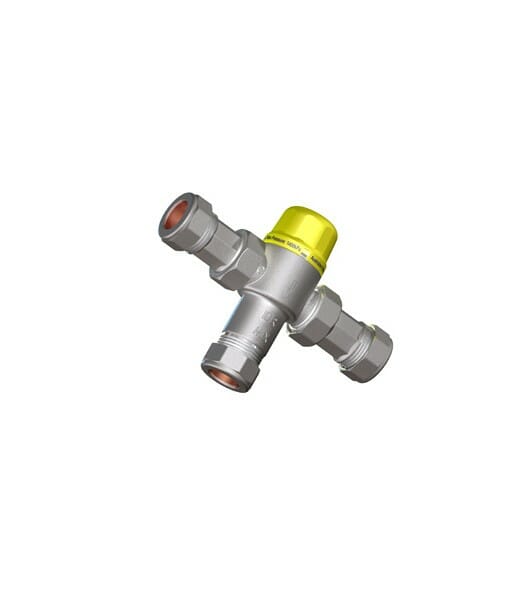Did you know that there is a small device called a tempering valve between your hot water system and your tap that keeps you and your family safe? Or at least – there should be!
In 2013 the Government updated the regulations for Australian plumbing standards so that every home, office or commercial business using hot water is required to have tempering valves fitted.
Here we help you understand what a tempering valve is and what the regulations are by answering the questions we most frequently get asked about them.
What is a Tempering Valve?
Tempering valves are safety devices designed to limit the temperature of the hot water coming out of your tap. It mixes the extremely hot water that comes directly from the hot water system with cold water from the general water supply to send out water at whatever the maximum temperature the valve is set to.
How Does it Work?
The tempering valve consists of 3 connections: two inlets for the hot and cold water and one outlet for the water after it is mixed. It keeps water temperatures consistent by using a thermostatic element to control the flow.
The element is submerged in the water and responds to temperature changes by expanding and contracting, adjusting the flow of each inlet valve to ensure the set temperature is maintained. The thermostatic element is accurate to within 3 degrees, so temperatures can vary plus or minus 3 degrees from its setting.
What Are The Regulations?
The law requires that tempering valves be used to limit a tap’s hot water supply to 50 degrees in most homes or businesses. The exception to these rules is facilities like nursing homes, day-care centres and health care providers that take care of vulnerable people with more sensitive skin.
These places come under a different regulation that requires temperatures to be set to a maximum of 45 degrees and they can instead use a thermostatic mixer – a different technology that is accurate to within 1 degree of the set temperature.
Why The Fuss?
Tempering valve regulations were introduced to counteract the potential danger from the simultaneous updates made to regulations for hot water storage. It was discovered and then mandated that to avoid the build-up and growth of harmful bacteria like legionnaires, hot water storage units must be set to a minimum of 60 degrees.
60 degrees is scalding hot and too dangerous to be readily available through a tap. It’s far too easy and extremely common to mistakenly mix water too hot for activities like doing the dishes, showers and baths. It only takes water at 60 degrees 5 seconds to give an adult a third-degree burn, and only 1 second for children.
This dangerous exposure time dramatically reduces to 5 minutes for water set to 50 degrees, demonstrating the safety objective of the regulations.
Are There Different Types of Valves?
There are different types of valves made to suit different types of hot water systems. Most use a colour coded system to differentiate between valve types, however, these colours can vary between brands.
Generally, the valves follow this guide:
|
COLOUR
|
RECOMMENDED USE
|
|
Black, blue or yellow
|
Standard tempering valve-Storage tanks for gas, electric and heat pump
|
|
Orange and some yellow valves
|
High performance tempering valve- Designed for solar applications and continuous flow hot water systems
|
|
Red
|
Transfer valve- Technically not a tempering valve though it looks similar. It delivers high temperatures to a kitchen sink or laundry
|
Can I Adjust My Tempering Valve?
A licensed plumber can adjust your tempering valve if you want to change the temperature it is set to. Legally, it cannot be lifted above the maximum of 50 degrees, but if you want to reduce the temperature to protect people in your house or business, a plumber can set the valve to a lower temperature. Most valves can be set between 35 to 50 degrees. This is not something you can do yourself and requires a professional.
How Do I Know if I Have a Tempering Valve and if it’s Working Properly?
If your hot water system was installed by a licensed professional after 2013, then it’s more than likely that you have a tempering valve already installed. They are a standard part of general hot water plumbing, and whenever plumbers install or replace hot water systems, they are required to fill out licensing paperwork to ensure the rules are followed.
Tempering valves have a life span of approximately 5 years, but you will likely pick up on the fact that it’s not working if it begins to fail.
Signs your tempering valve is becoming ineffective include loss of hot water, reduced hot water pressure or lower hot water temperatures. When this happens, you may not realise that it’s the tempering valves, but a professional plumber who performs hot water repairs will know what to look for and how to replace them.
Need Help With Your Hot Water System?
We are Australia’s largest online hot water system retailer and the leading experts in hot water with over 30 years of experience. We have teams of professional plumbers all over Australia that can assist you with hot water servicing, repairs, and installing hot water systems.
They are ready and waiting to answer any questions you have about tempering valves, water temperature settings or your hot water system.
